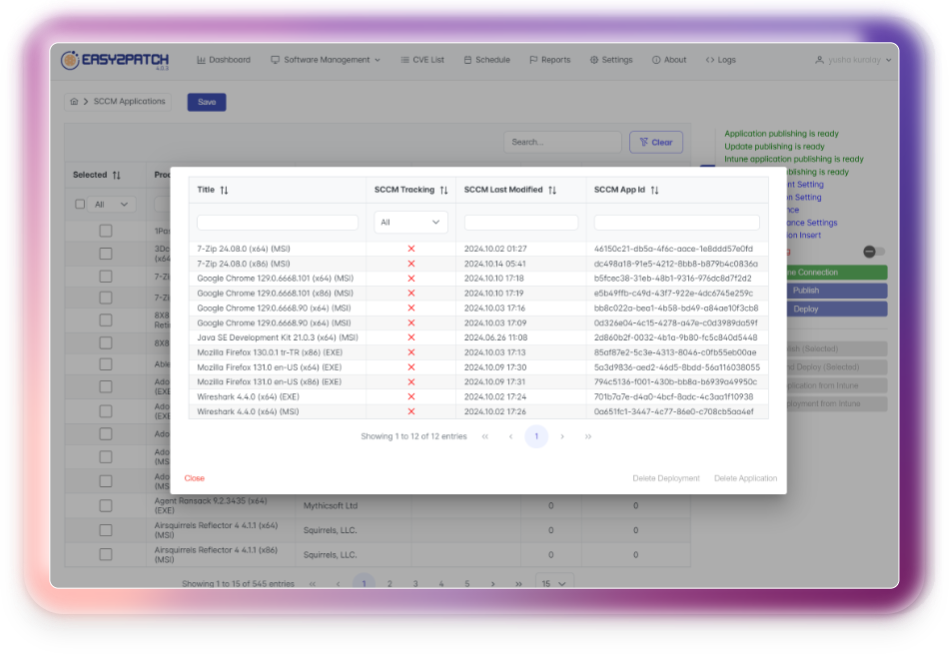SCCM Patch
Management for
Third Party Patching
Easy2Patch integrates with Microsoft SCCM to automatically manage software updatesand update third-party applications.

What is SCCM?
SCCM, now known as Microsoft Endpoint Configuration Manager, is a Microsoft product that allows you to manage both on-premises and cloud-based devices. SCCM serves as a crucial System Center tool for centralized management and monitoring of the current state of devices within an organization. It encompasses various roles, including operating system deployment, application deployment, update deployment, and mobile device management.
Additionally, it features an advanced inventory tracking system. SCCM patch management is not limited to these functions alone; it seamlessly integrates with Active Directory and WSUS to provide effective functionality and user-friendliness.
With the correct setup, SCCM can relay Microsoft-provided updates to endpoints at specific intervals, ensuring that systems remain up to date. However, for third party SCCM patching, a catalog must be provided to SCCM.
Examples of such third-party applications include Google Chrome, Mozilla Firefox, and WinRAR, which are widely used and require regular updates. To address this, Easy2Patch can be used in conjunction with SCCM. The integration of SCCM and Easy2Patch allows for automatic updates of third-party applications.
SCCM also enables application deployment. It allows for the distribution of internally used applications to new computers or the centralized deployment of a new application across all machines.
Patching in SCCM is a streamlined process when dealing with both Microsoft and third party updates.Easy2Patch is recommended for this purpose as well.
Configuration Manager not only facilitates distribution and updates but also provides capabilities for device management and tracking. Devices can be tracked individually or grouped together for management and monitoring purposes. For instance, you can create separate groups for Windows 10 and Windows 7 devices within your organization. With the SCCM agent installed on devices, you can manage processes such as power management, hardware inventory, and reporting.
-
Centralized Management
SCCM is a package with centralized SCCM patch management capabilities, allowing the management of numerous computers from a single point.
-
Software Deployment
SCCM centralizes software distribution, including third-party apps, crucial for automating tasks and addressing security vulnerabilities
-
Remote Management
SCCM provides the ability to manage computers remotely, eliminating the need for physical presence at a specific location.
-
Mobile Device Management
In addition to PCs, SCCM manage smartphones and tablets, providing comprehensive device management solutions.
-
Operating System Deployment
SCCM facilitates the distribution of operating systems, making new device setups and existing device enhancements remarkably easy.
-
Endpoint Protection
SCCM can integrate with Windows Defender antivirus, enhancing endpoint protection. SCCM patching plays a crucial role in maintaining the security of endpoints..
-
Installation Complexity
SCCM has a complex installation and configuration process that requires careful setup.
-
Licensing Costs
SCCM licensing costs can be high, especially for larger organizations.
-
High Hardware Requirements
SCCM demands significant hardware resources for efficient operation.
-
Update Management
Managing updates in complex network structures with SCCM can require meticulous attention, and issues with endpoint update access may arise.
-
Workforce Requirements
Having experienced personnel familiar with patching in SCCM is crucial for effective usage, making it challenging for beginners to use and manage..
-
Configuration Errors
Improper installation or configuration of SCCM can have far-reaching consequences, affecting both the software itself and disrupting the entire network.
-
Organization Size and Windows Investment
Large organizations heavily invested in Windows may already use SCCM patch management to manage their Windows devices and workstations.
-
Integration and Single Pane of Glass
An all-in-one endpoint management platform can offer benefits such as integration with various systems and providing visibility through a single pane of glass.
-
Non-Windows Environments
If your organization doesn't use 100% Windows, you'll need additional tools outside of the Microsoft ecosystem to manage your devices effectively.
-
Alternatives to SCCM
Microsoft is modernizing their toolset for device management, and tools like Intune may make more sense for most use cases.
-
Server Management
SCCM can be an effective solution for organizations that require robust server management capabilities.
-
Endpoint Management Modernization
Microsoft's toolset for device management is evolving, and tools like Intune are being introduced to address modern management needs.
Get started with our patch management software for free
Get 30 Day Premium TrialSCCM for Patch Management
SCCM simplifies and streamlines patch management, making it more organized. It allows for centralized tracking of updates, patches, and compliance, which in turn facilitates the prevention of security vulnerabilities, ensures compliance, and keeps computer systems current and secure. However, effective utilization of SCCM is essential. Additionally, when it comes to SCCM patch management, strategies for deployment and maintaining business continuity and system stability are critical.
Here, the IT team also plays a crucial role because providing an SCCM catalog for third-party applications falls under their responsibility. The use and provisioning of this catalog are the responsibilities of the IT team. For example, Google frequently sends updates lately. The IT team must keep track of these updates, prepare packages, and deliver them to endpoints promptly. Can the IT team do this quickly for every update that arrives within a week? The answer is likely no. This is where Easy2Patch comes into play. With SCCM and Easy2Patch, you can automate the delivery process entirely, reducing security vulnerabilities to a minimum.


Why Easy2Patch for SCCM Patch Management
While Microsoft SCCM excels at managing applications and software distribution, handling third-party applications is not its forte. E2P Patch Manager steps in to enhance SCCM. It allows users to deploy third-party software via SCCM patching, in addition to its existing patch management capabilities. E2P Patch Manager ensures:
- Downloading the correct files from the right sources
- Keeping applications deployed in SCCM up-to-date
- Allowing end users to install and uninstall applications from the software center
- Finding and determining unattended installation parameters
